Associations between Public Fear of COVID-19 and Number of COVID-19 Vaccinations: A County-Level Longitudinal Analysis
Abstract
:1. Introduction
2. Method
2.1. Research Design
2.2. Dependent Variable
2.3. Independent Variables
2.4. Statistical Analysis
3. Results
4. Discussion
5. Conclusions
Author Contributions
Funding
Institutional Review Board Statement
Informed Consent Statement
Data Availability Statement
Conflicts of Interest
Appendix A
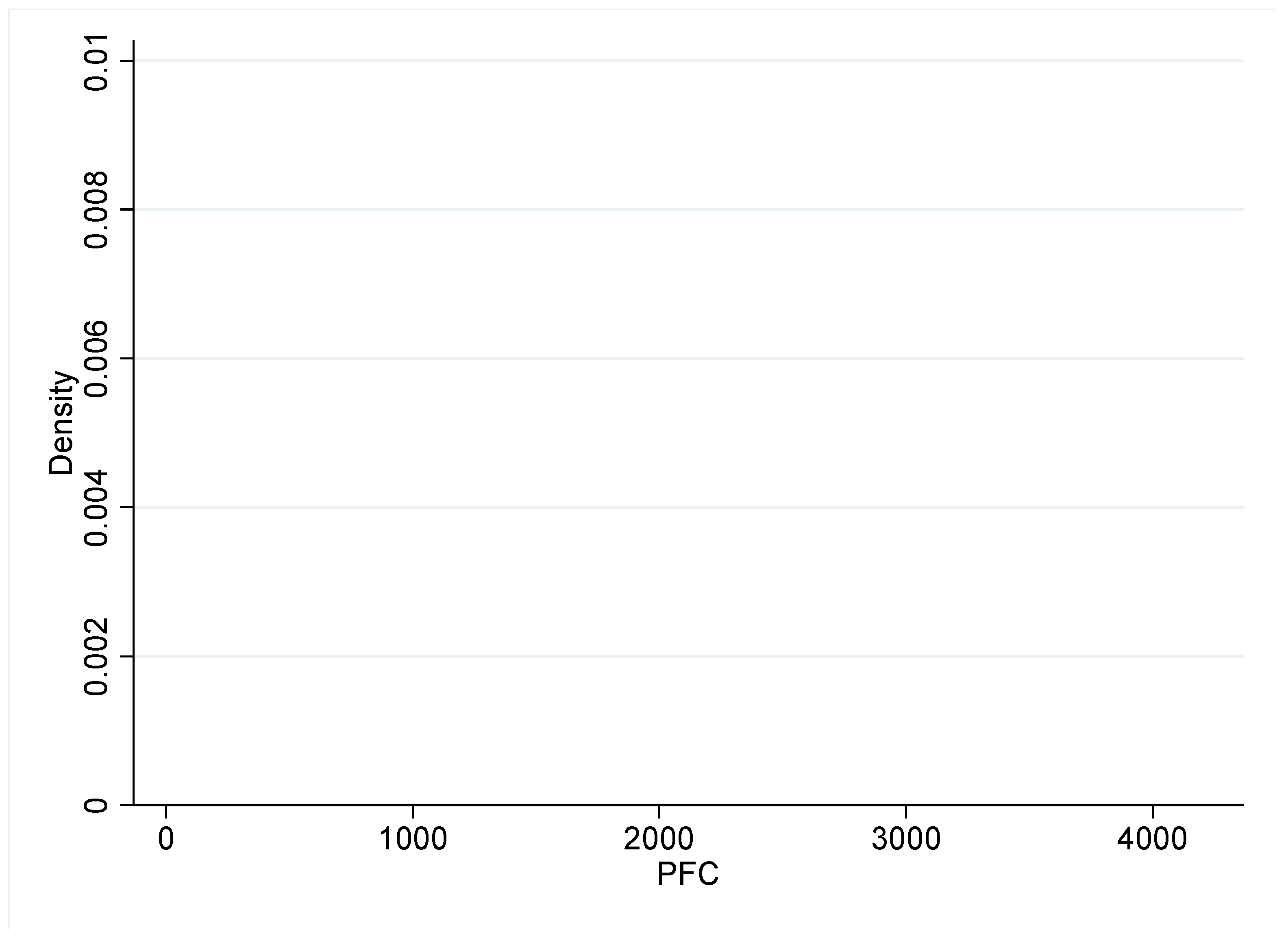
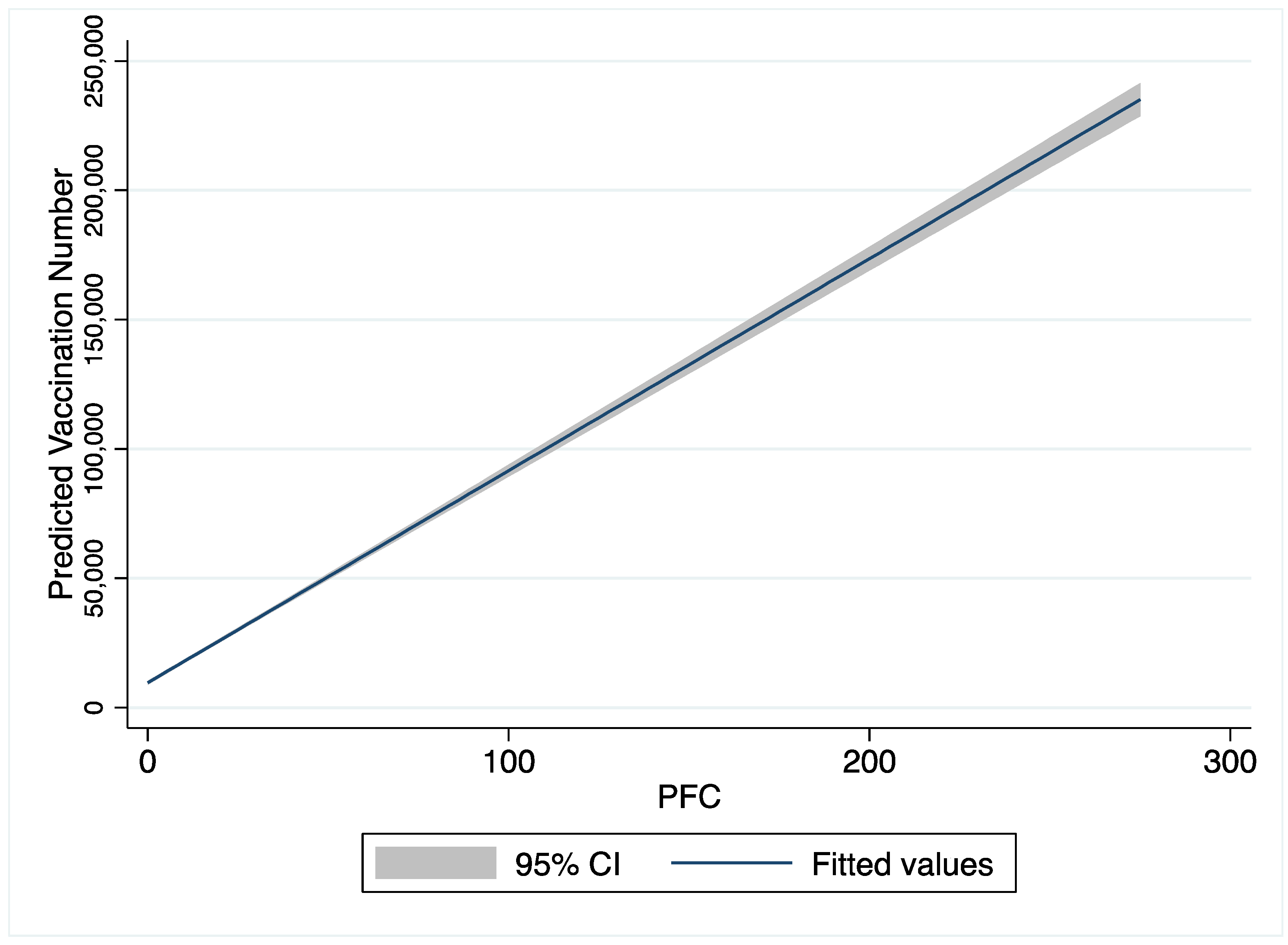
References
- Trends, V. COVID Data Tracker. Available online: https://covid.cdc.gov/covid-data-tracker/#datatracker-home (accessed on 25 August 2022).
- Hall, M.C.; Prayag, G.; Fieger, P.; Dyason, D. Beyond panic buying: Consumption displacement and COVID-19. J. Serv. Manag. 2020, 32, 113–128. [Google Scholar] [CrossRef]
- Sim, K.; Chua, H.C.; Vieta, E.; Fernandez, G. The anatomy of panic buying related to the current COVID-19 pandemic. Psychiatry Res. 2020, 288, 113015. [Google Scholar] [CrossRef] [PubMed]
- Kawohl, W.; Nordt, C. COVID-19, unemployment, and suicide. Lancet Psychiatry 2020, 7, 389–390. [Google Scholar] [CrossRef]
- Blustein, D.L.; Duffy, R.; Ferreira, J.A.; Cohen-Scali, V.; Cinamon, R.G.; Allan, B.A. Unemployment in the Time of COVID-19: A Research Agenda; Elsevier: Berlin/Heidelberg, Germany, 2020; Volume 119, p. 103436. [Google Scholar]
- Gangopadhyaya, A.; Garrett, A.B. Health Insurance, and the COVID-19 Recession (1 April 2020). 2020. Available online: https://ssrn.com/abstract=3568489 (accessed on 6 April 2020).
- Talevi, D.; Socci, V.; Carai, M.; Carnaghi, G.; Faleri, S.; Trebbi, E.; di Bernardo, A.; Capelli, F.; Pacitti, F. Mental health outcomes of the CoViD-19 pandemic. Riv. Psichiatr. 2020, 55, 137–144. [Google Scholar]
- Moreno, C.; Wykes, T.; Galderisi, S.; Nordentoft, M.; Crossley, N.; Jones, N.; Cannon, M.; Correll, C.U.; Byrne, L.; Carr, S. How mental health care should change as a consequence of the COVID-19 pandemic. Lancet Psychiatry 2020, 7, 813–824. [Google Scholar] [CrossRef]
- Pfefferbaum, B.; North, C.S. Mental health and the Covid-19 pandemic. N. Engl. J. Med. 2020, 383, 510–512. [Google Scholar] [CrossRef] [PubMed]
- Cavallo, A. Inflation with Covid Consumption Baskets; National Bureau of Economic Research: Cambridge, MA, USA, 2020; Available online: http://ssrn.com/abstract=3626853 (accessed on 27 June 2021).
- Zhu, Y.; Zhang, L.; Zhou, X.; Li, C.; Yang, D. The impact of social distancing during COVID-19: A conditional process model of negative emotions, alienation, affective disorders, and post-traumatic stress disorder. J. Affect. Disord. 2021, 281, 131–137. [Google Scholar] [CrossRef]
- Dixon, T. “Emotion”: The history of a keyword in crisis. Emot. Rev. 2012, 4, 338–344. [Google Scholar] [CrossRef]
- Jin, Y.; Pang, A.; Cameron, G.T. Integrated crisis mapping: Toward a publics-based, emotion-driven conceptualization in crisis communication. Sphera Publica 2007, 7, 81–95. [Google Scholar]
- Lindquist, K.A.; Barrett, L.F. Constructing emotion: The experience of fear as a conceptual act. Psychol. Sci. 2008, 19, 898–903. [Google Scholar] [CrossRef]
- Ruiter, R.A.; Abraham, C.; Kok, G. Scary warnings and rational precautions: A review of the psychology of fear appeals. Psychol. Health 2001, 16, 613–630. [Google Scholar] [CrossRef]
- DeSteno, D.; Gross, J.J.; Kubzansky, L. Affective science and health: The importance of emotion and emotion regulation. Health Psychol. 2013, 32, 474. [Google Scholar] [CrossRef] [PubMed]
- Slovic, P.; Peters, E. Risk perception and affect. Curr. Dir. Psychol. Sci. 2006, 15, 322–325. [Google Scholar] [CrossRef]
- Peters, E.; Lipkus, I.; Diefenbach, M.A. The functions of affect in health communications and in the construction of health preferences. J. Commun. 2006, 56, S140–S162. [Google Scholar] [CrossRef]
- Gao, J. Social Media Use in Public Health and Policy Study. Doctoral Thesis, The University of North Carolina at Charlotte, Charlotte, NC, USA, 2022. [Google Scholar]
- Addicott, A.K.; Gray, J.J.; Todd, B.L. Mood, dietary restraint, and women’s smoking and eating urges. Women Health 2009, 49, 310–320. [Google Scholar] [CrossRef]
- Perkins, K.A.; Lerman, C.; Grottenthaler, A.; Ciccocioppo, M.M.; Milanak, M.E.; Conklin, C.A.; Bergen, A.W.; Benowitz, N.L. Dopamine and opioid gene variants are associated with increased smoking reward and reinforcement due to negative mood. Behav. Pharmacol. 2008, 19, 641. [Google Scholar] [CrossRef]
- Kelly, A.B.; Masterman, P.W.; Young, R.M. Negative mood, implicit alcohol-related memory, and alcohol use in young adults: The moderating effect of alcohol expectancy. Addict. Behav. 2011, 36, 148–151. [Google Scholar] [CrossRef]
- Ostafin, B.D.; Brooks, J.J. Drinking for relief: Negative affect increases automatic alcohol motivation in coping-motivated drinkers. Motiv. Emot. 2011, 35, 285–295. [Google Scholar] [CrossRef]
- Loxton, N.J.; Dawe, S.; Cahill, A. Does negative mood drive the urge to eat? The contribution of negative mood, exposure to food cues and eating style. Appetite 2011, 56, 368–374. [Google Scholar] [CrossRef]
- Roghani, A. The influence of Covid-19 vaccine on daily cases, hospitalization, and death rate in Tennessee: A case study in the United States. medRxiv 2021, 2, e29324. [Google Scholar]
- Andrews, N.; Stowe, J.; Kirsebom, F.; Toffa, S.; Sachdeva, R.; Gower, C.; Ramsay, M.; Lopez Bernal, J. Effectiveness of COVID-19 booster vaccines against COVID-19-related symptoms, hospitalization and death in England. Nat. Med. 2022, 28, 831–837. [Google Scholar] [CrossRef] [PubMed]
- Chapman, G.B.; Coups, E.J. Emotions and preventive health behavior: Worry, regret, and influenza vaccination. Health Psychol. 2006, 25, 82. [Google Scholar] [CrossRef] [PubMed]
- Luz, P.; Brown, H.; Struchiner, C. Disgust as an emotional driver of vaccine attitudes and uptake? A mediation analysis. Epidemiol. Infect. 2019, 14, e1827. [Google Scholar] [CrossRef] [PubMed] [Green Version]
- Purtle, J. COVID-19 and mental health equity in the United States. Soc. Psychiatry Psychiatr. Epidemiol. 2020, 55, 969–971. [Google Scholar] [CrossRef]
- Pieh, C.; Budimir, S.; Probst, T. The effect of age, gender, income, work, and physical activity on mental health during coronavirus disease (COVID-19) lockdown in Austria. J. Psychosom. Res. 2020, 136, 110186. [Google Scholar] [CrossRef] [PubMed]
- Guo, Y.; Sims, O.T.; Qin, W.; Yang, F. Factors associated with symptoms of depression and psychological distress during the COVID-19 pandemic. Behav. Sci. 2021, 11, 13. [Google Scholar] [CrossRef]
- Guo, Y.; Kaniuka, A.R.; Gao, J.; Sims, O.T. An epidemiologic analysis of associations between county-level per capita income, unemployment rate, and COVID-19 vaccination rates in the United States. Int. J. Environ. Res. Public Health 2022, 19, 1755. [Google Scholar] [CrossRef]
- Solís Arce, J.S.; Warren, S.S.; Meriggi, N.F.; Scacco, A.; McMurry, N.; Voors, M.; Syunyaev, G.; Malik, A.A.; Aboutajdine, S.; Adeojo, O. COVID-19 vaccine acceptance and hesitancy in low- and middle-income countries. Nat. Med. 2021, 27, 1385–1394. [Google Scholar] [CrossRef]
- Walkey, A.J.; Law, A.; Bosch, N.A. Lottery-based incentive in Ohio and COVID-19 vaccination rates. JAMA 2021, 326, 766–767. [Google Scholar] [CrossRef]
- Law, A.C.; Peterson, D.; Walkey, A.J.; Bosch, N.A. Lottery-based incentives and COVID-19 vaccination rates in the US. JAMA Intern. Med. 2022, 182, 235–237. [Google Scholar] [CrossRef]
- Duch, R.M.; Barnett, A.; Filipek, M.; Roope, L.; Violato, M.; Clarke, P. Cash versus Lotteries: COVID-19 Vaccine Incentives Experiment. medRxiv 2021. [Google Scholar] [CrossRef]
- Guo, Y.; Gao, J.; Sims, O.T. Associations between Bonus and Lottery COVID-19 Vaccine Incentive Policies and Increases in COVID-19 Vaccination Rates: A Social Epidemiologic Analysis. Trop. Med. Infect. Dis. 2022, 7, 118. [Google Scholar] [CrossRef] [PubMed]
- Xue, J.; Chen, J.; Hu, R.; Chen, C.; Zheng, C.; Su, Y.; Zhu, T. Twitter discussions and emotions about the COVID-19 pandemic: Machine learning approach. J. Med. Internet Res. 2020, 22, e20550. [Google Scholar] [CrossRef]
- Kleinberg, B.; van der Vegt, I.; Mozes, M. Measuring emotions in the covid-19 real world worry dataset. arXiv 2020, arXiv:2004.04225. [Google Scholar]
- Marzana, D.; Novara, C.; De Piccoli, N.; Cardinali, P.; Migliorini, L.; Di Napoli, I.; Guidi, E.; Fedi, A.; Rollero, C.; Agueli, B. Community dimensions and emotions in the era of COVID-19. J. Commun. Appl. Soc. Psychol. 2022, 32, 358–373. [Google Scholar] [CrossRef] [PubMed]
- Aslam, F.; Awan, T.M.; Syed, J.H.; Kashif, A.; Parveen, M. Sentiments and emotions evoked by news headlines of coronavirus disease (COVID-19) outbreak. Humanit. Soc. Sci. Commun. 2020, 7, 1–9. [Google Scholar] [CrossRef]
- Altheide, D.L. Creating Fear: News and the Construction of Crisis; Routledge: New York, NY, USA, 2018. [Google Scholar]
- Pakpour, A.H.; Griffiths, M.D. The fear of COVID-19 and its role in preventive behaviors. J. Concurr. Disord. 2020, 2, 58–63. [Google Scholar] [CrossRef]
- Winter, T.; Riordan, B.C.; Pakpour, A.H.; Griffiths, M.D.; Mason, A.; Poulgrain, J.W.; Scarf, D. Evaluation of the English version of the Fear of COVID-19 Scale and its relationship with behavior change and political beliefs. Int. J. Ment. Health Addict. 2020, 1–11. [Google Scholar] [CrossRef]
- Labrague, L.J.; de Los Santos, J.A.A. Fear of Covid-19, psychological distress, work satisfaction and turnover intention among frontline nurses. J. Nurs. Manag. 2021, 29, 395–403. [Google Scholar] [CrossRef]
- Huynh, T.L.D. “The more I fear about COVID-19, the more I wear medical masks”: A survey on risk perception and medical masks’ uses. MedRxiv 2020. [Google Scholar] [CrossRef]
- Kaim, A.; Siman-Tov, M.; Jaffe, E.; Adini, B. From isolation to containment: Perceived fear of infectivity and protective behavioral changes during the COVID-19 vaccination campaign. Int. J. Environ. Res. Public Health 2021, 18, 6503. [Google Scholar] [CrossRef] [PubMed]
- Centers for Disease Control and Prevention. Centers for Disease Control and Prevention COVID Data Tracker: Cases & c. 2021. Available online: https://covid.cdc.gov/covid-data-tracker/#datatracker-home (accessed on 25 August 2022).
- Gaglio, S.; Re, G.L.; Morana, M. A framework for real-time Twitter data analysis. Comput. Commun. 2016, 73, 236–242. [Google Scholar] [CrossRef]
- Lee, K.; Agrawal, A.; Choudhary, A. Real-Time Disease Surveillance Using Twitter Data: Demonstration on Flu and Cancer. In Proceedings of the 19th ACM SIGKDD International Conference on Knowledge Discovery and Data Mining, Chicago, IL, USA, 11–14 August 2013; pp. 1474–1477. [Google Scholar] [CrossRef]
- Chin, T.; Kahn, R.; Li, R.; Chen, J.T.; Krieger, N.; Buckee, C.O.; Balsari, S.; Kiang, M.V. US county-level characteristics to inform equitable COVID-19 response. MedRxiv 2020. [Google Scholar] [CrossRef] [Green Version]
- Long, C.; Lucey, B.M.; Yarovaya, L. ‘I Just Like the Stock’ versus ‘Fear and Loathing on Main Street’: The Role of Reddit Sentiment in the GameStop Short Squeeze. SSRN 2021, 3822315. [Google Scholar] [CrossRef]
- Di Sotto, S.; Viviani, M. Health Misinformation Detection in the Social Web: An Overview and a Data Science Approach. Int. J. Environ. Res. Public Health 2022, 19, 2173. [Google Scholar] [CrossRef]
- Ramírez-Sáyago, E. Sentiment Analysis from Twitter Data Regarding the COVID-19 Pandemic. Available online: https://www.researchgate.net/publication/346453096_Sentiment_Analysis_from_Twitter_Data_Regarding_the_COVID-19_Pandemic (accessed on 1 November 2020).
- Kumar, P.; Reji, R.E.; Singh, V. Extracting Emotion Quotient of Viral Information Over Twitter; International Conference on Distributed Computing and Internet Technology; Springer: Berlin/Heidelberg, Germany, 2022; pp. 210–226. [Google Scholar] [CrossRef]
- West, J.; Gao, J.; Jang, S. The Factors and Behaviors Associated with Legislator Use of Communication Technology; Rowman & Littlefield: Lanham, MD, USA, 2021. [Google Scholar]
- Gao, J. The complementary and substitutive value of online health information. Health Soc. Care Commun. 2022, 30, e3029–e3040. [Google Scholar] [CrossRef]
- West, J. Legislator Use of Communication Technology: The Critical Frequency Theory of Policy System Stability; Lexington Books: Lanham, MD, USA, 2018. [Google Scholar]
- Dooling, K. The Advisory Committee on Immunization Practices’ updated interim recommendation for allocation of COVID-19 vaccine—United States, December 2020. MMWR Morb. Mortal. Wkly. Rep. 2021, 69, 1657. [Google Scholar] [CrossRef]
- Haselton, M.G.; Ketelaar, T. Irrational emotions or emotional wisdom? The evolutionary psychology of affect and social behavior. Affect Soc. Think. Behav. 2006, 8, 21. [Google Scholar]
- Clore, G.L.; Schwarz, N.; Conway, M. Affective causes and consequences of social information processing. Handb. Soc. Cogn. 1994, 1, 323–417. [Google Scholar]
- Buck, R. The biological affects: A typology. Psychol. Rev. 1999, 106, 301. [Google Scholar] [CrossRef]
- Andrade, E.B.; Ariely, D. The enduring impact of transient emotions on decision making. Organ. Behav. Hum. Decis. Process. 2009, 109, 1–8. [Google Scholar] [CrossRef]
- So, J.; Achar, C.; Han, D.; Agrawal, N.; Duhachek, A.; Maheswaran, D. The psychology of appraisal: Specific emotions and decision-making. J. Consum. Psychol. 2015, 25, 359–371. [Google Scholar] [CrossRef]
- Sołtys, A.; Sowińska-Gługiewicz, I.; Chęć, M.; Tyburski, E. Emotions in Decision Making. In Neuroeconomic and Behavioral Aspects of Decision Making; Springer: Berlin/Heidelberg, Germany, 2017; pp. 35–47. [Google Scholar] [CrossRef]
- Melki, J.; Tamim, H.; Hadid, D.; Farhat, S.; Makki, M.; Ghandour, L.; Hitti, E. Media exposure and health behavior during pandemics: The mediating effect of perceived knowledge and fear on compliance with COVID-19 prevention measures. Health Commun. 2022, 37, 586–596. [Google Scholar] [CrossRef] [PubMed]
- Friedman, M. Nobel lecture: Inflation and unemployment. J. Political Econ. 1977, 85, 451–472. [Google Scholar] [CrossRef]
- Crump, R.K.; Nekarda, C.J.; Petrosky-Nadeau, N. Unemployment Rate Benchmarks. SSRN 2020. [Google Scholar] [CrossRef]
- Ali, K.; Zain-ul-Abdin, K.; Li, C.; Johns, L.; Ali, A.A.; Carcioppolo, N. Viruses going viral: Impact of fear-arousing sensationalist social media messages on user engagement. Sci. Commun. 2019, 41, 314–338. [Google Scholar] [CrossRef]
- Ayandele, O.; Ramos-Vera, C.A.; Iorfa, S.K.; Chovwen, C.O.; Olapegba, P.O. Exploring the complex pathways between the fear of COVID-19 and preventive health behavior among nigerians: Mediation and moderation analyses. Am. J. Trop. Med. Hyg. 2021, 105, 701. [Google Scholar] [CrossRef]
- Yıldırım, M.; Geçer, E.; Akgül, Ö. The impacts of vulnerability, perceived risk, and fear on preventive behaviours against COVID-19. Psychol. Health Med. 2021, 26, 35–43. [Google Scholar] [CrossRef]
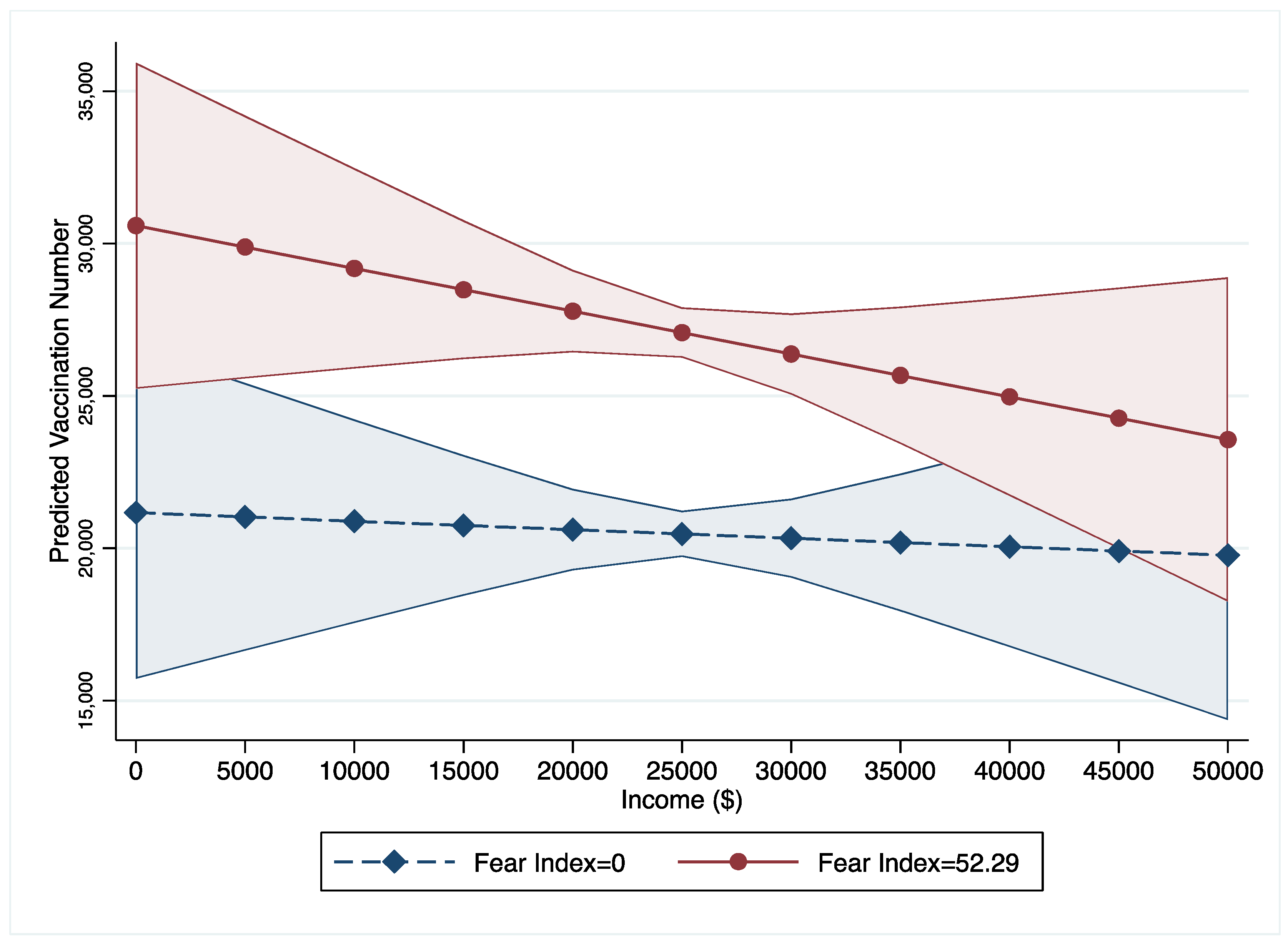
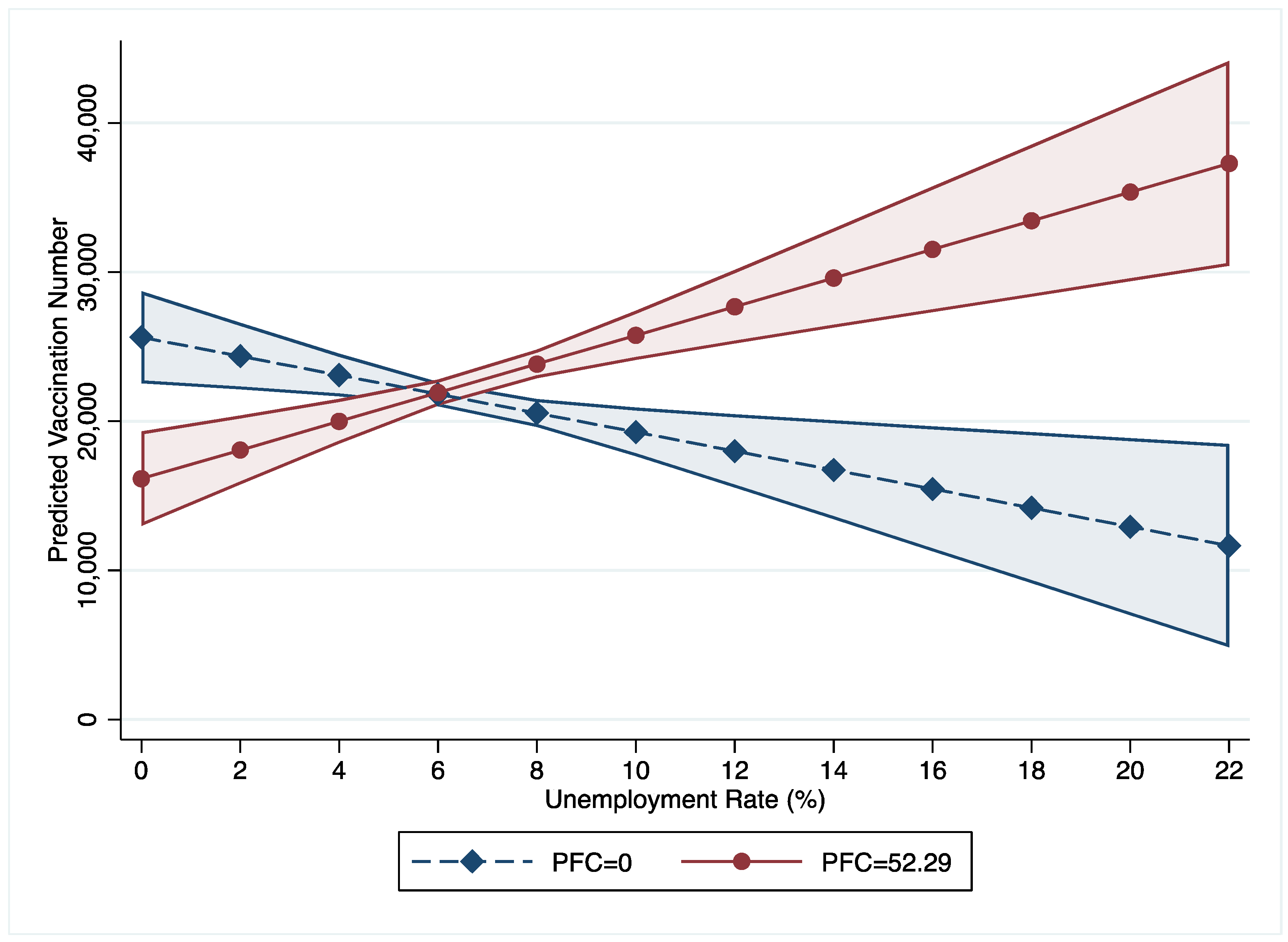
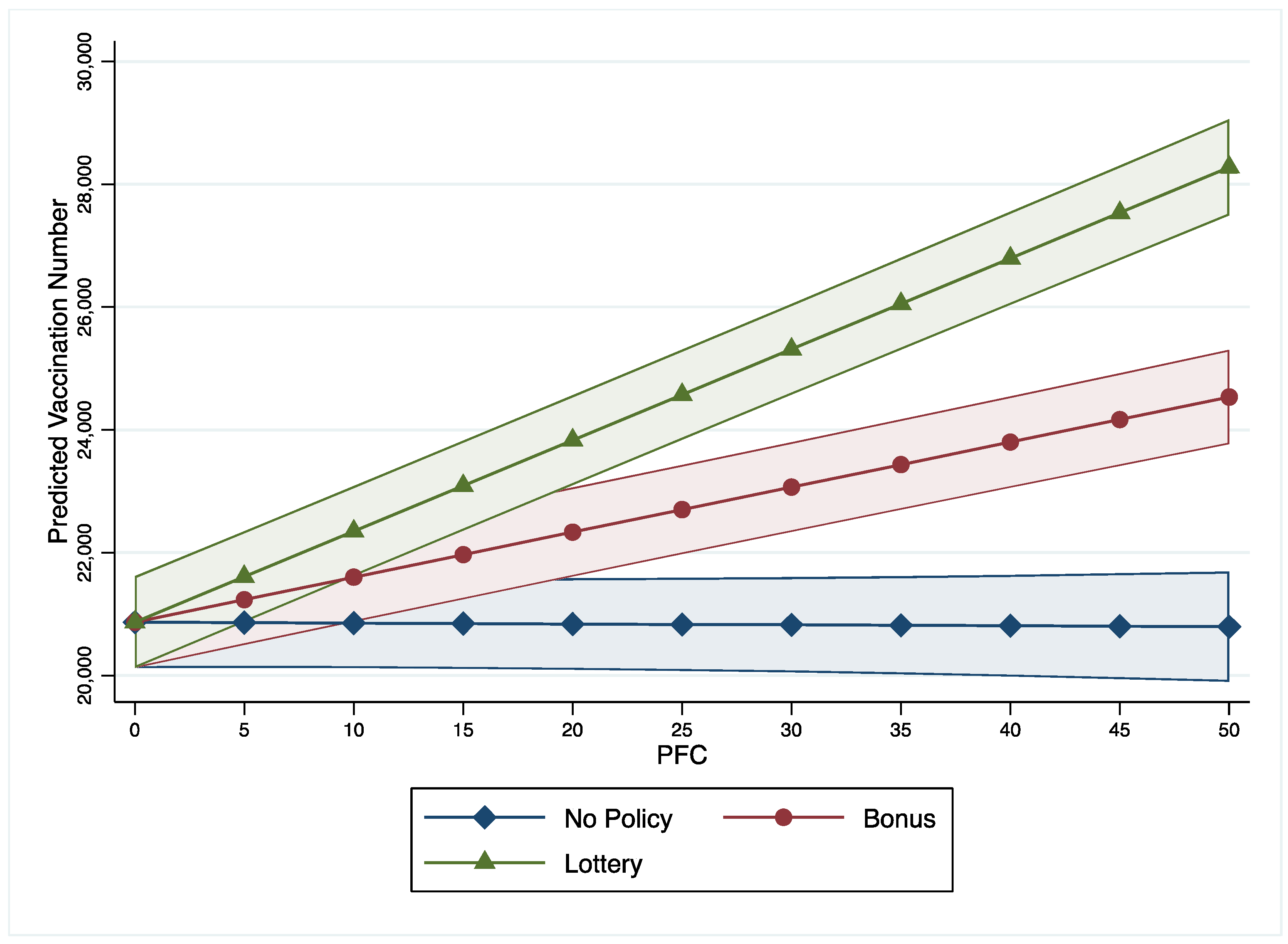
| Variable | Mean | Std. Dev. | Min | Max | Median | Interquartile Range (IQR) | N |
|---|---|---|---|---|---|---|---|
| Vaccine uptake | 23,026.71 | 98,075.98 | 0 | 4,804,352 | 3505.50 | 10,883 | 17,142 |
| Vaccine uptake rate by population | 0.19 | 0.15 | 0 | 2.27 | 0.17 | 0.24 | 17,136 |
| PFC | 23.06 | 132.91 | 0 | 4286.00 | 22.90 | 4.00 | 17,142 |
| New infected | 710.89 | 3868.21 | 0 | 33,0525 | 711.08 | 362.00 | 16,982 |
| Days of vaccines availability | 29.07 | 34.04 | 0 | 107 | 29.25 | 57.00 | 17,142 |
| Days of incentive policy | 2.86 | 9.54 | 0 | 55 | 2.87 | 0.00 | 17,142 |
| Biden support proportion | 34.07 | 15.86 | 4.97 | 92.15 | 0.34 | 0.21 | 17,142 |
| Total nurse practitioners | 54.58 | 156.17 | 0.23 | 3937.77 | 54.29 | 31.85 | 17,142 |
| Unemployment rate 2020 | 6.72 | 2.23 | 1.7 | 22.5 | 6.71 | 2.80 | 17,142 |
| Per capita income ($) | 25,091.53 | 5996.03 | 9688.43 | 66,518.36 | 25,074.69 | 6957.57 | 17,142 |
| Percent of bachelor’s degree | 21.83 | 9.55 | 5.40 | 78.50 | 21.82 | 11.00 | 17,142 |
| Percentage of Black and Indigenous People of Color (BIPOC) | 15.47 | 16.11 | 9.11 | 93.71 | 0.16 | 0.17 | 17,136 |
| Percentage of population aged 65 and above | 19.41 | 4.56 | 4.83 | 57.58 | 0.19 | 0.05 | 17,136 |
| Population log | 10.33 | 1.46 | 6.14 | 16.13 | 10.32 | 1.79 | 17,136 |
| (1) | (2) | (3) | (4) | |
|---|---|---|---|---|
| Interaction Models | ||||
| Variables | Initial Model | Income | Unemployment | Vaccine Policy |
| PFC | 109.1 *** | 180.1 *** | −181.5 *** | 4.917 |
| (4.208) | (13.41) | (11.67) | (6.787) | |
| New infected | −11.52 *** | −11.57 *** | −11.82 *** | −11.58 *** |
| (0.124) | (0.124) | (0.122) | (0.122) | |
| Days of vaccines availability | 245.2 *** | 244.4 *** | 242.9 *** | 247.2 *** |
| (12.78) | (12.77) | (12.52) | (12.60) | |
| Days of incentive policy | 217.8 *** | 217.6 *** | 214.0 *** | 200.9 *** |
| (48.19) | (48.15) | (47.22) | (47.51) | |
| Biden support proportion | 6206 | 5146 | 3416 | 4470 |
| (4470) | (4470) | (4381) | (4411) | |
| Total nurse practitioners | 614.0 *** | 612.1 *** | 579.9 *** | 601.4 *** |
| (4.678) | (4.686) | (4.759) | (4.667) | |
| Unemployment rate | −114.3 | −117.1 | −635.8 ** | −69.31 |
| (230.4) | (230.2) | (226.6) | (227.4) | |
| Per capita income ($) | −0.148 | −0.0280 | 0.0795 | −0.130 |
| (0.108) | (0.110) | (0.106) | (0.106) | |
| Percent of bachelor’s degree | −166.6 * | −162.3 * | −47.71 | −99.06 |
| (80.06) | (80.00) | (78.57) | (78.99) | |
| BIPOC | −13,736 *** | −11,457 ** | −5335 | −12,329 *** |
| (3506) | (3527) | (3450) | (3463) | |
| Population aged 65 and above | −976.7 | −1192 | 12,854 | 11,398 |
| (10,056) | (10,047) | (9867) | (9929) | |
| Population log | −2828 *** | −2806 *** | −243.6 | −1482 *** |
| (421.6) | (421.3) | (424.4) | (420.3) | |
| Bonus | −1665 | −1466 | −1937 | 38.91 |
| (1326) | (1325) | (1299) | (1353) | |
| Lottery | 2935 ** | 3236 *** | 3003 ** | −282.8 |
| (937.7) | (938.5) | (918.8) | (937.2) | |
| Fear index × Per capita income | −0.00215 *** | |||
| (0.000386) | ||||
| Fear index × Unemployment rate | 30.54 *** | |||
| (1.148) | ||||
| Bonus × Fear index | −80.64 *** | |||
| (19.70) | ||||
| Lottery × Fear index | 143.1 *** | |||
| (7.223) | ||||
| Constant | 24,028 *** | 20,760 *** | −7491 | 8224 |
| (5131) | (5160) | (5165) | (5107) | |
| Observations | 16,976 | 16,976 | 16,976 | 16,976 |
| Number of Counties | 2856 | 2856 | 2856 | 2856 |
Publisher’s Note: MDPI stays neutral with regard to jurisdictional claims in published maps and institutional affiliations. |
© 2022 by the authors. Licensee MDPI, Basel, Switzerland. This article is an open access article distributed under the terms and conditions of the Creative Commons Attribution (CC BY) license (https://creativecommons.org/licenses/by/4.0/).
Share and Cite
Gao, J.; Guo, Y.; Ademu, L. Associations between Public Fear of COVID-19 and Number of COVID-19 Vaccinations: A County-Level Longitudinal Analysis. Vaccines 2022, 10, 1422. https://doi.org/10.3390/vaccines10091422
Gao J, Guo Y, Ademu L. Associations between Public Fear of COVID-19 and Number of COVID-19 Vaccinations: A County-Level Longitudinal Analysis. Vaccines. 2022; 10(9):1422. https://doi.org/10.3390/vaccines10091422
Chicago/Turabian StyleGao, Jingjing, Yuqi Guo, and Lilian Ademu. 2022. "Associations between Public Fear of COVID-19 and Number of COVID-19 Vaccinations: A County-Level Longitudinal Analysis" Vaccines 10, no. 9: 1422. https://doi.org/10.3390/vaccines10091422
APA StyleGao, J., Guo, Y., & Ademu, L. (2022). Associations between Public Fear of COVID-19 and Number of COVID-19 Vaccinations: A County-Level Longitudinal Analysis. Vaccines, 10(9), 1422. https://doi.org/10.3390/vaccines10091422







